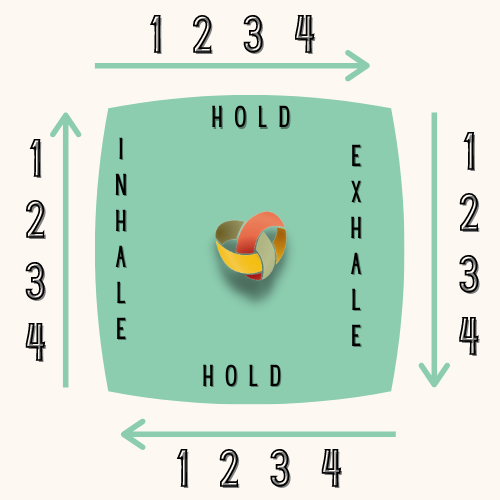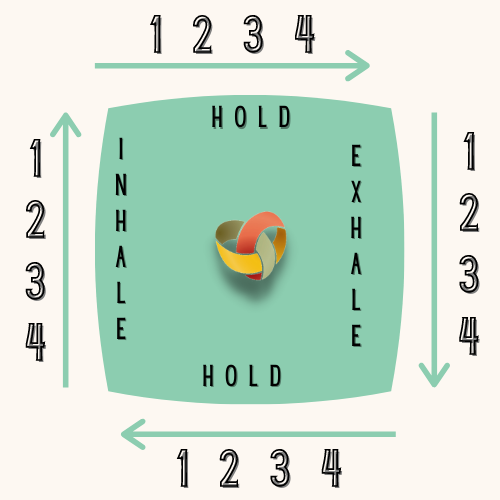Breathing for Stress Management
Posted by Maria Droste Counseling Center on Mar 24, 2021 in Stress and Anxiety
Desplácese para leer el blog en español.
The last year has brought new and intensified stress into many people’s lives, and the need for stress management tools has perhaps never been greater. There are many ways of managing stress, and you might already have your own unique stress-soothing techniques. Yet there is one pervasive and universally effective method that is backed by scientific evidence— breathing, for stress management.
Before you check that off thinking, “I’m already doing that!” you should know that there’s an important distinction between the background process of breathing and breathing for stress management. You can actually harness your breath to quell feelings of stress and anxiety. This way, you reap benefits that are both psychological and physiological. Sounds pretty good, right?
The Scientific Basis: Why Breathing Works
You’ve probably come across terms like deep breathing, mindfulness, meditation, visualization and other stress management and relaxation techniques. These ideas are more than just the latest wellness trend. There is substantial scientific evidence demonstrating that breathing exercises are key to effective, long-term stress management.
To understand why breathing can be such a powerful tool for managing stress and anxiety, we turn to the autonomic nervous system. A system within your brain and body that directs automatic responses. This includes everything from heart rate to digestion to something called the “fight or flight” response.
It’s that fight or flight response that is key here. When we become anxious or stressed the autonomic nervous system activates a response that was designed to prepare us to literally fight or run. The heart rate increases, breathing becomes shallow and quick, digestion is put on pause, and the brain and body are kicked into high gear, sometimes without our even realizing it. This is an essential response when facing danger, high-pressure situations, or when we need to rise to a challenge.
Fight or Flight in the Modern World
However, it’s meant to be a once-in-a-while tool. Being in this state takes a toll on the body and mind. If it is a regular occurrence, it can lead to high blood pressure, immune system suppression and long-lasting anxiety and depression. So, when this state is activated by daily stressors, we are putting ourselves at risk for health problems. Not to mention, it’s simply an unpleasant way to go through your daily life!
While that all sounds scary, luckily there is a very simple way to take back control of this autonomic response. This fight or flight response can be activated by external stressors or anxious thoughts. Alternatively, it can also be activated by breathing. Taking a series of short, shallow breaths can actually induce this autonomic stress response.
On the flip side, we can control the breath to prevent this response and calm the body and mind. Focusing on slowing and deepening your breathing cues your autonomic nervous system to switch out of fight or flight mode. You will move into a more relaxed state; slowing the heart rate, calming the mind, and, well, making you feel a whole lot better!
A Few Basic Methods to Get You Started
There are many, many techniques that can help you benefit from the effects of deep breathing. If you begin to incorporate this stress management tool into your daily life, you’ll likely want to experiment with a few and find what works best for you. Luckily, there is also a proliferation of resources. These come in the form of YouTube videos, podcasts, audio books and more to help you find techniques, new breathing exercises, and mindful moments to incorporate into your day to manage stress. To get you started, however, we’ve collected some basic techniques to introduce you to breathing for stress management.
Belly Breathing
This is the simplest way to begin to experiment with breathing exercises. All you need is a few quiet moments. It is best if you can lay down or stretch out, as you’ll then rest one hand on your belly. Your other hand will either be on your chest or simply next to you. Then, breathe in deeply through your nose until you can feel your belly begin to expand. Feel your hand gently rise with it. Exhale gently but fully from your mouth, feeling your hand fall as your belly contracts.
Most people go about their day chest breathing—that is breathing shallowly and only in their chest. When you engage in belly breathing, also known as deep breathing or diaphragmatic breathing, you are filling your lungs completely. You will literally feel your belly rise as your diaphragm expands fully. This will increase the rate of oxygenation in your blood, slow down your heart rate, and calm your mind.
Breathing Patterns
Breathing techniques for stress management that incorporate specific patterns can be helpful for those that struggle with anxious thoughts and focusing on breathing. This technique gives your mind something to do as you are doing your deep breathing exercises. Thus allowing you to stay in the moment and remain focused on your breath. There are many variations of patterned breathing exercises, but some common patterned breathing exercises are square breathing and 4-7-8 breathing.

To illustrate, in square breathing you will inhale for a count of four. Then gently hold that breath for a count of four, exhale for four, and finally, pause once again for four. You’ve just made a square with your breath. Slowing your heart rate, and simultaneously taking a mental break from the thoughts that were leading to high stress levels. In this same vein, you can design your own pattern of breathing based on what works best for you. Inhale deeply through your nose to a comfortable count, and exhale to an equal or slightly higher or lower count. You can of course incorporate pauses at the top and bottom of the breath, too.
Visualization

Finally, some people find that visualization is the most effective way for them to practice deep breathing. There are many different versions, but some common visualizations are that of a balloon filling as you breathe in and popping as you exhale. Or the image of a tide coming in and out. Some even visualize the pathway of inhalation, from your nostrils all the way to the deepest corners of your lungs. Thanks to the popularization of breathing as a stress management tool, you can also find an endless variety of guided visualizations for breathing online.
The beauty of breathing for stress management is that you can feel the benefits even if you only have a few moments to dedicate to it. Start with 10 breaths and work your way up to practicing deep breathing for a few minutes a day. While breathing is a wonderful way to manage stress, you may find that you would benefit from more guidance. To speak to a counselor about managing stress in your life, contact Maria Droste’s Access Center at 303-867-4600.
Written by Chloe Heskett

Depression is treatable!
For $50, you could support someone coping with trauma to find joy and safety again. Thanks for ensuring your community receives the mental healthcare they need, regardless of ability to pay.
Respiraciones para Manejar el Estrés
Posteado por Maria Droste Counseling Centre el 24 de marzo de 2021 en Estrés y ansiedad.
El último año ha traído un estrés nuevo e intensificado a la vida de muchas personas y la necesidad de herramientas para el manejo del estrés quizás nunca haya sido mayor. Hay muchas formas para manejar el estrés y es posible que ya tengas tus propias técnicas únicas para aliviarlo. Sin embargo, existe un método generalizado y universalmente eficaz para aliviar el estrés que incluso está respaldado por pruebas científicas: la respiración.
Antes de que digas: “¡Ya lo estoy hago!”, debes de saber que existe una distinción importante entre el proceso regular de respiración y la respiración para el manejo del estrés. De hecho, puedes aprovechar la respiración para calmar los sentimientos de estrés y ansiedad. De esta forma, obtienes beneficios tanto psicológicos como fisiológicos. Suena bastante bien, ¿verdad?
La Base Científica: Por Qué Funciona la Respiración
Probablemente te hayas encontrado con términos como respiración profunda, atención plena, meditación, visualización y otras técnicas de relajación y manejo del estrés. Estas ideas son más que la última tendencia de bienestar. Existe evidencia científica sustancial que demuestra que los ejercicios de respiración son clave para el manejo eficaz del estrés a largo plazo.
Para comprender por qué la respiración puede ser una herramienta tan poderosa para controlar el estrés y la ansiedad recurrimos al sistema nervioso autónomo. Un sistema dentro de tu cerebro y cuerpo que dirige las respuestas automáticas. Esto incluye todo, desde la frecuencia cardíaca hasta la digestión y algo llamado respuesta de “lucha o huida”.
Es esa respuesta de lucha o huida la clave aquí. Cuando nos ponemos ansiosas o ansiosos o estresadas o estresados, el sistema nervioso autónomo activa una respuesta que fue diseñada para prepararnos para literalmente luchar o huir. La frecuencia cardíaca aumenta, la respiración se vuelve superficial y rápida, la digestión se pone en pausa y el cerebro y el cuerpo se aceleran a veces sin que nos demos cuenta. Esta es una respuesta esencial cuando nos enfrentamos a situaciones peligrosas, de alta presión o cuando necesitamos enfrentarnos a un desafío.
Lucha o Huida en el Mundo Moderno
Sin embargo, éste está destinado a ser una herramienta que se utilice de vez en cuando. Estar en este estado afecta el cuerpo y la mente. Si ocurre con regularidad, puede provocar presión arterial alta, supresión del sistema inmunológico y ansiedad y depresión duraderas. Entonces, cuando este estado es activado por factores estresantes diarios, nos ponemos en riesgo de tener problemas de salud. ¡Sin mencionar que es simplemente una manera desagradable de experimentar tu día a día!
Si bien todo esto suena aterrador, afortunadamente hay una forma muy sencilla de recuperar el control de esta respuesta autónoma. Esta respuesta de lucha o huida puede ser activada por factores estresantes externos o pensamientos de ansiedad. Alternativamente, también se puede activar al respirar. Hacer una serie de respiraciones breves y superficiales puede inducir esta respuesta autónoma al estrés.
Por otro lado, podemos controlar la respiración para prevenir esta respuesta y calmar el cuerpo y la mente. Concentrarse en reducir la velocidad y profundizar la respiración le indica a tu sistema nervioso autónomo que puede salir del modo de lucha o huida. Pasarás a un estado más relajado; desacelera el ritmo cardíaco, calma la mente y, bueno, ¡te hace sentir mucho mejor!
Algunos Métodos Básicos para Comenzar
Hay muchas, muchas técnicas que pueden ayudarte a beneficiarse de los efectos de la respiración profunda. Si comienzas a incorporar esta herramienta de manejo del estrés en tu vida diaria es probable que desees experimentar con algunas otras y así encontrar la que funcione mejor para ti. Por suerte, también hay una una abundancia de recursos. Puedes encontrarlos en forma de videos de YouTube, podcasts, audiolibros y más para ayudarte a encontrar técnicas, nuevos ejercicios de respiración y momentos conscientes para incorporar a tu día y así controlar el estrés. Sin embargo, para comenzar, hemos recopilado algunas técnicas básicas para presentarle este método de manejo del estrés.
Respiración del Vientre
Esta es la forma más sencilla de comenzar a experimentar con ejercicios de respiración. Todo lo que necesitas son unos momentos de tranquilidad. Es mejor si puedes recostarte o estirarte, ya que luego apoyarás una mano sobre tu vientre. Tu otra mano estará sobre tu pecho o simplemente junto a ti. Luego, respira profundamente por la nariz hasta que sientas que tu vientre comienza a expandirse. Siente cómo tu mano se eleva suavemente al mismo tiempo. Exhala lentamente pero completamente de tu boca, sintiendo tu mano caer mientras tu vientre se contrae.
La mayoría de las personas siguen respirando en el pecho durante el día, es decir, respirar superficialmente y sólo en el pecho. Cuando realizas la respiración abdominal, también conocida como respiración profunda o respiración diafragmática, estás llenando tus pulmones por completo. Literalmente, sentirás que tu vientre se eleva a medida que tu diafragma se expande por completo. Esto aumentará la tasa de oxigenación en tu sangre, disminuirá tu frecuencia cardíaca y calmará tu mente.
Patrones de Respiración
Las técnicas de respiración que incorporan patrones específicos pueden ser útiles para aquellos que luchan con pensamientos de ansiedad y se concentran en la respiración. Esta técnica le da a tu mente algo que hacer mientras realizas tus ejercicios de respiración profunda, permitiéndote así permanecer en el momento y mantenerte concentrada o concentrado en tu respiración. Hay muchas variaciones de ejercicios de respiración con patrones, pero algunos ejercicios de respiración con patrones comunes son la respiración cuadrada y la respiración 4-7-8.

Para ilustrarlo, en la respiración cuadrada, inhalarás contando hasta cuatro. Luego, sostén suavemente esa respiración mientras cuentas hasta cuatro, exhala durante cuatro y, finalmente, haz una pausa una vez más durante cuatro segundos. Acabas de hacer un cuadrado con tu respiración, disminuir tu frecuencia cardíaca y, al mismo tiempo, tomar un descanso mental de los pensamientos que te llevaban a niveles altos de estrés. En esta misma línea, puedes diseñar tu propio patrón de respiración en función de lo que funcione mejor para ti. Inhala profundamente por la nariz con un conteo cómodo y exhala con un conteo igual o ligeramente mayor o menor. Por supuesto, también puedes incorporar pausas en la parte superior e inferior de la respiración.
Visualización
Finalmente, algunas personas consideran que la visualización es la forma más efectiva de practicar la respiración profunda. Hay muchas versiones diferentes pero algunas visualizaciones comunes son la de un globo que se llena al inhalar y que estalla al exhalar. O la imagen de una marea entrando y saliendo. Hay quienes incluso visualizan la vía de la inhalación, desde las fosas nasales hasta los rincones más profundos de los pulmones. Gracias a la popularización de la respiración como herramienta de manejo del estrés, también puedes encontrar una variedad infinita de visualizaciones guiadas para respirar en línea.

La belleza de los ejercicios de respiración recae en que puedes sentir los beneficios incluso si sólo tienes unos momentos para ejercitarte. Comienza con 10 respiraciones y continúa hasta practicar la respiración profunda durante unos minutos al día. Si bien la respiración es una forma maravillosa de controlar el estrés, es posible que te beneficies de una orientación más amplia. Para hablar con una consejera o consejero sobre cómo manejar el estrés en tu vida, comunícate con Maria Droste Access Center al 303-867-4600.
Escrita por Chloe Heskett. Traducido por Sandra Dolores Gómez, Amador.
Need Help?
If you would like to speak to a therapist about this subject or about any other issue you may be experiencing, contact the Maria Droste Access Center at 303-867-4600.
Get Informative Posts like this Sent to Your Inbox
Maria Droste posts regularly on helpful mental health and wellness subjects like the one you just read. We send these out in our free monthly newsletter. Subscribe today and get informative reads like this sent straight to your inbox.
